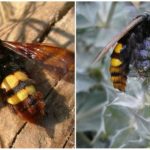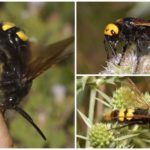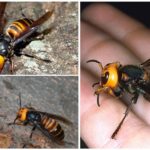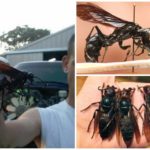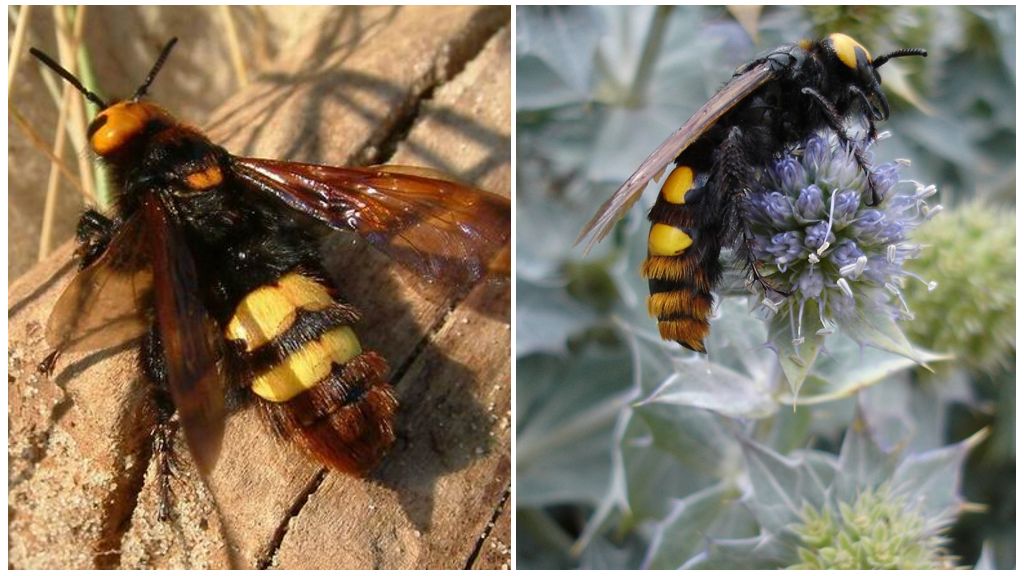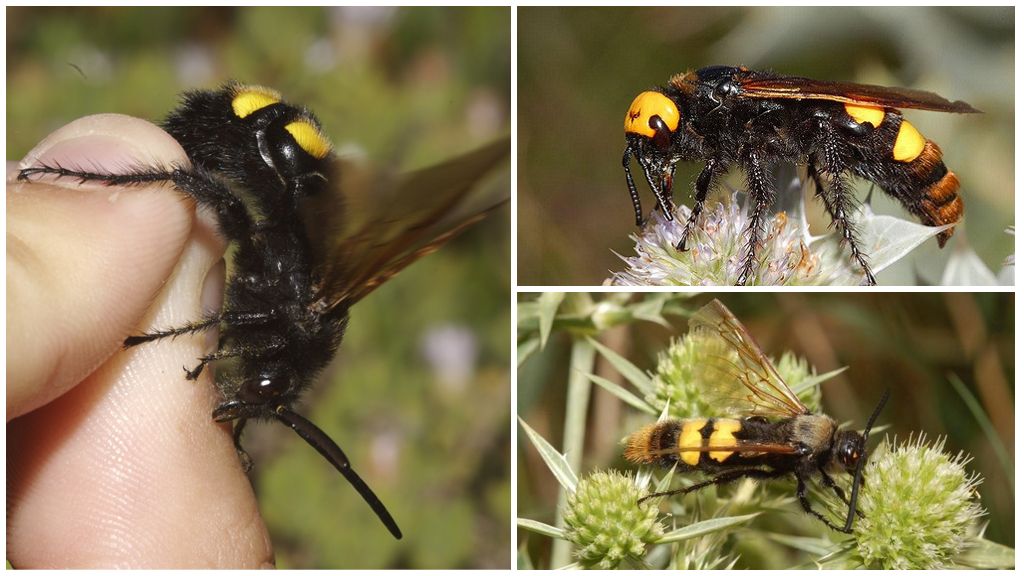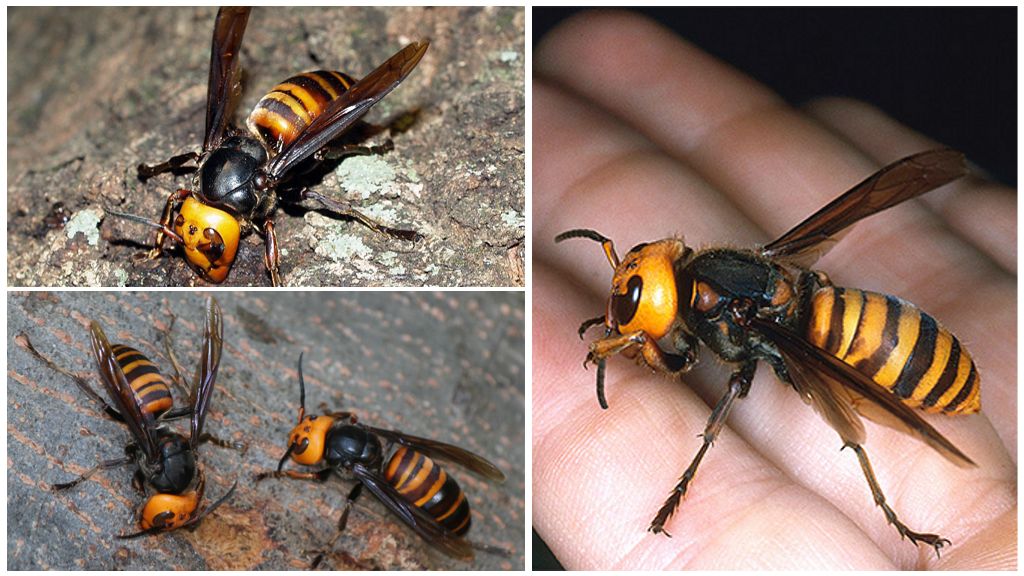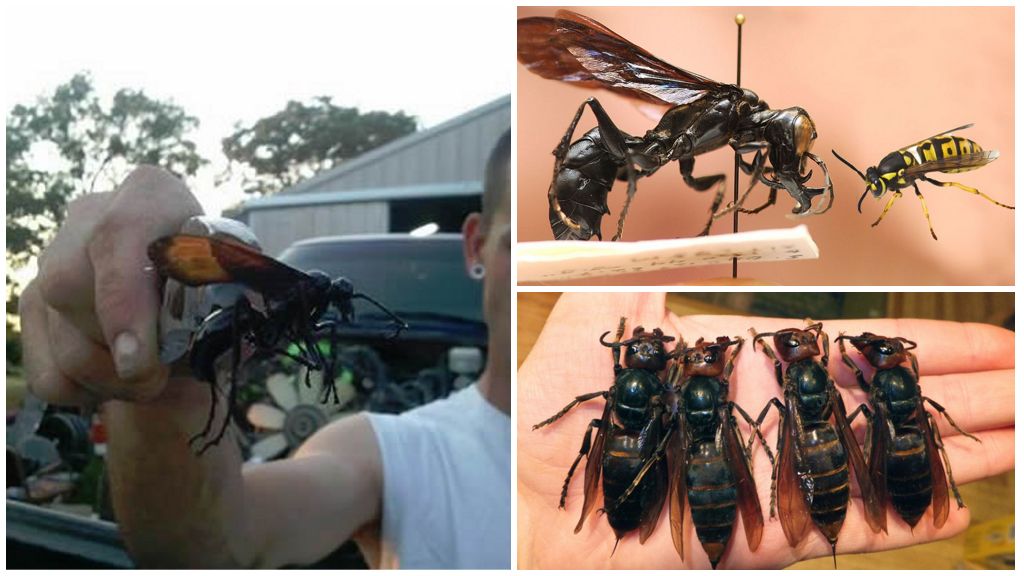Description and photos of giant wasps
Content
- Giant colia or spotted scoli
- Giant colia or spotted scoli
- Asian Hornet
- Osa Megalar Garuda
The giant giant scolium or the spotted wasp is the largest species of the entire hymenoptera order in Europe. Listed in the Red Book in Russia, Ukraine. Giant wasps reach 55 mm in size. The scoliosis wasp belongs to predators, but for humans it is almost not dangerous.
Appearance Description
The big wasp is called spotted scolia or giant scolia.
- The size of the female is from 32 to 55 mm, the males are smaller in size - about 32 mm.
- The main color is black. The anterior part of the sternum is bright yellow. Wide wings with a purple tint.
- The front part of the back, the abdomen is covered with small red hairs, the rest of the body is long black.
- The head is round, shiny, yellow. Nape matte black. Curved antennae on head, eyes wide apart.
A photo of a big wasp is presented below.
Habitat large Scoli
In the world there are about 1 thousand species of scoli. There are about 25 in the CIS countries. There are three subspecies in the world: Megascolia maculata bischoffi, Megascolia maculata flavifrons, Megascolia maculata maculata. The main part of these insects lives in tropical, subtropical zones. Huge wasp lives in North America, Africa, Southern Europe, the Middle East, Turkey, Crimea, Central Asia, Russia.
The giant giant colia lives in a forest, forest-steppe, mountainous area. It rises in the mountains to an altitude of 1150 m above sea level.
On a note!
The spotted wasp lives in an area where there are large lamellar beetles, since their larvae are necessary for laying eggs of the wasp family.
Lifestyle giant scoli
The biggest wasp in the world belongs to primitive creatures, leads a solitary life. It shows activity during the day, buries in the forest floor, grass at night. The imago feeds on fruit juices, nectar of flowers, but protein food is required to feed the larvae.
The female lays eggs directly into the body of the victim, or feeds the larvae on their own, hunting large bugs and their offspring - rhinos, some species of white beetles. Attacks the victim, paralyzes poison. In this state, the beetle does not die, but is immobilized. This allows you to keep food fresh for a long time. It takes 12 days for the scolium wasp larvae to eat the beetle. As a result, only wings remain from the victim.
In most cases, the female digs into the ground, finds a larva, stings, lays an egg into the body. After some time, the parasite larva appears, which eats the insides of the victim, and pupates into its completion. In this state winters. In the spring there is a young individual. The big wasp is active in May, June.
Interesting!
Unlike social networksrepresentatives of large cholies do not communicate with each other, do not give each other signs, signals. Insect does not build complex nests, and the process of hunting is hidden from all, because it takes place underground. The most famous types of cholium are steppe, giant.
Reproduction of large spotted scoli
The mating period is limited, as in many species. Young adults mate in May. In June the female is busy laying eggsgetting food for the larvae. By the end of the summer, the female already plans the victims, who will become food and a place of development for young offspring.
A fertilized female digs a hole in the ground, drags a paralyzed victim there, lays an egg on her belly. It is selected outside, it falls asleep to the ground. Each larva requires a separate hole, its own victim. Further development, the maturing of the offspring occurs without the participation of the female.
Interesting!
The larva begins to eat the prey from the least important organs, leaving it alive for a long time. Lastly, the circulatory, nervous system is damaged. At the end of its development, it weaves a cocoon, pupates, it remains to winter in this form. In spring, young females appear, males ready for mating.
Danger to man, the benefit of large scoli
Despite its impressive appearance, the spotted wasp does not pose any particular danger to humans. Insect lives in the wild, does not build nests under the roof of outbuildings, in attics, balconies. To meet her is much more difficult than with the usual social wasps.
Large wasp does not possess toxic poison, due to the strength of painful sensations, the possibility of development allergic reaction much inferior to public kinsmen. Unlike them, a large scolium does not attack with a swarm, because it does not know how to transmit signals.
The temper of the spotty is the peace loving. She prefers not to conflict, but to move away from an unfavorable place. Overly annoying offenders do not pay attention, continues to do their work.
Collecting nectar, large scoli are actively involved in pollination of some plant species. Undoubted favor bring, destroying the larvae of beetles, which spoil the garden, garden crops, trees. Many land owners are not at all opposed to the giant scolia living in its territory, and some specially bring the females to their lands.
Other types of big wasps
The spotted stains are the most beautiful representative of large insects. But there are giants whose external unattractiveness is combined with danger, aggressiveness.
Asian Hornet
The largest wasp in the world is striking in its size, behavior, and the power of poison. According to official data, in Japan and China, 50 people die each year from the bite of a giant wasp. We are talking about asian hornet vespamandariniathat belongs to the genus real wasps. The size reaches 6 cm in length, the wingspan is 7.5 cm. The color of the body of a hefty insect is black and yellow.
Giant wasps live in forests near water bodies. They belong to the public wasps. The head of the genus is the female uterus. It lays the foundation for the future aspen nest. Huge insects build a hive with the whole family. The finished structure is 80 cm wide, 50 cm in diameter.
Working individuals to provide food for the larvae, to satisfy their hunger, make frequent raids on bee hives. Honey, nectar is eaten, paralyzed bees are taken to the honeycomb for feeding calves.
On a note!
Many tourists, seeing a huge wasp, try to consider it or take a picture.The insect perceives it as aggression, rushes to attack. The bite is comparable to piercing the skin with a hot nail. The poison is extremely toxic, but it is saved by the fact that the aggressor pulls out the sting, sparingly consumes the poison. In one bite, it injects about 2 mg of a poisonous substance.
Large wasps are dangerous to humans due to a strong allergic reaction, a general deterioration of health. There is swelling, redness, rash, pain, lowering blood pressure, headache, signs of intoxication, breathing problems, cramps. The situation is complicated if the wasp attacked several times or there were several individuals.
Megalar Garuda
A new type of large-sized wasps was discovered in Indonesia, officially introduced in 2012. The body size of the male is about 32 mm, the female grows to almost 5 cm. The powerful jaws and long mustaches are essentially distinguished from the aspen family of this huge representative. Because of the terrifying appearance of the Megalar Garuda, the locals gave the name Komodo monitor lizard. It belongs to the genus of sandy wasps, is a predator, because it eats other insects. Some sources call this species the largest wasp in the world.

